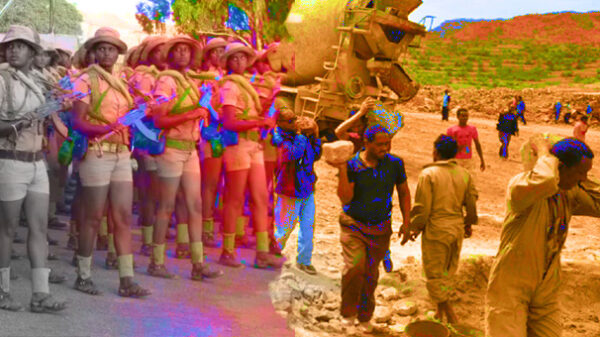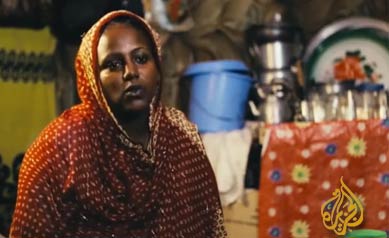Appraising Eritrea’s Social Media ( Part 1)

There now exists a ‘’different’’ Eritrea in the cyberspace, what can be called a ‘’virtual diasporic nation’’ of the free, populated mostly by the young and recent émigrés. This community of activists, working across the transnational space and without fear of retribution, has the potential to inject new vigor and a sense of direction to the bogged-down, dislocated, strife-ridden, and moribund politics of Eritrea. And thus help design and chart a new future of hope, peace, mutual security and development for our distressed country and millions of its down-trodden. Today, as we all ‘’celebrate’’ 23 years of frustration, a historic opportunity is offering itself, giving us the chance to correct the trajectory of history. Are we up to the job!?
This article (and a follow-up under a heading: Reigning in our Elephant) will try to assess the current realities and challenges within this virtual ‘’nation’’ and provide a global context, and at the same time point out potential areas where social media tools (SMTs) can be effectively utilized to advance the cause of serious democratic forces. I would like, though, at the outset, to stress that this modest attempt is not exhaustive, and it is only meant to spur the engagement of more privy professionals and actors of the field of social media.
The Prevailing Conundrum
Lies, innuendoes, and facts are proffered on the same floor. Our common history continues to hold center stage, riveting some, tormenting others, and arousing the revisionary aspirations of yet many more. And, in the meantime, current history is being kept in-check, transfixed, a hostage of its own past, while a whole country and its citizens (…or, prisoners-in-wait) are held in bondage, weighing- with trepidation- the probability of ‘life’ in the expanding gulags of Eritrea or trying their chance across Eritrea’s porous borders, an exit that has increasingly become full of tragic twists of its won.
Certain corners use it as a bully pulpit to spread the diseases of cultural arrogance and spin and re-spin familiar and new conspiracy theories fit for a thriller movie. Mudslinging has long since sullied the façade. Frustration, hopelessness, and cynicism have become a fixture of the daily narrative. Sanctimony, self-righteousness and exaggerated sense of victimization abounds. Many a guest speaker, on so many different occasions, keep turning virtual conference rooms into a one- man- show court room by taking on the role of a judge, jury, and executioner. The Arabic and Tigrigna language based media continue to drift apart, separated by a real (…or imagined) dark and raging sea of mistrust and suspicion. There is no shortage of know-it-all types with their ready hodgepodge panacea for the multi-ailments of a severely distressed country.
And, in the hands of human traffickers, smugglers, and hostage takers, the tools of the media have proven to be an efficient means for executing the mission of their seedy trade: transfer of money, extorted or otherwise.
Social media tools (SMTs) – the Internet, Facebook, YouTube, Twitter, and Text Messaging, etc. – are starting to change the stale façade of Eritrean politics. Socioeconomic and technological barriers of communication have been knocked down, the confines of time and space conquered, and the playing field has become level for all and sundry. Today, you don’t have to be ‘’somebody’’ in order to be ‘’somebody’’ in the virtual world of social media; and, the average individual with humble origins and little educational background can access, interact, and even create and share digital contents of his or her own making.
And, just a quick glance at the flourishing online community gives about enough evidence to suggest that Eritreans too are flocking to this virtual niche, as ‘’netizens’’ of a vibrant global activist community. The demographics of this community indicate, as mentioned above, a young and mostly male population, members of the fleeing young population from Eritrea. But there is also significant evidence to presume that older and well established Eritreans in the Diaspora are also increasingly becoming exasperated with their conventional and limited role, that of remittance to keep the souls and bodies of their dependents back home together.
This recent phenomenon is lending a ‘’ welcome’’ dimension to the politics of Eritrea, an endeavor largely left for the opposition parties, an assortment of parties comprised of ‘relics’ from Eritrea’s struggle for Independence, and a recent addition of ethnic, religious, and secular ones. These traditional opposition parties have largely failed to tap into the impatience, anger, and frustration of Eritreans in general and especially more so with the young population. And the use, by some corners, of pejorative epithets to describe the perceived political apathy of the youth has not helped either; it has only reinforced the dissatisfaction of the youth. These accumulated feeling of alienation and the perennial stifling repressive situation at home with the prospects of a bleak and inescapable future will most likely keep on swelling the ranks of the latter.
And, surely but slowly, leaders of both the opposition and the illegitimate and kleptocratic regime in Eritrea are waking up to this fact. There is now a growing and grudging acknowledgement, in both circles, about the potential of this growing youth activism.
I believe the above development calls for a sobering thought and a series of queries: What will be the effect of this new dimension for the political future of Eritrea? How will the opposition position itself: is it going to reflect its current spectrum and try to drive wedges in a way that reflects its narrow interests? What about the regime: Will it institute a series of reforms to attenuate for the push factor and increase the pull factor? What about the youth itself: how will it handle its new found spotlight? How is it going to respond to the increasing jostling for attention from many competing actors (Eritrean and non-Eritrean) while at the same time negotiating the murky political landscape of Eritrea and the ‘’horny’’ region as a whole? And, lastly, an all-important question: Is this going to reinvigorate the stalled momentum for change and bring a swift deliverance to the millions of the suffering flesh within and outside Eritrea? Or just add another confounding factor to the reigning conundrum?
The linchpin for Eritrea’s future lies in its social capital; and, it is getting eroded by the day. The current ruling regime has outdone every previous colonizer in every aspect of evil, but its most destructive legacy will be the heavy damage that it has callously inflicted on Eritrea’s social fabric. And the philosophy of opposition politics (- at least, some of it) is making a hopeless situation worse, as some of the trend seems to be discerning dividing lines and exaggerating differences rather than seeking a common platform. There are also worrying symptoms that the ‘’viral afflictions’’ of the old are seeping into the virtual space. Familiar echoes of intolerance, arrogance, infatuation with history, and fragmentation have recently become an attendant cacophony as participants keep futilely egging on each other on historical anecdotes, issues of polemics, and political irrelevances.
SMTs- interrelated forms of digital ICT, including the Internet, computer and mobile phone- are positing a dynamic double-edged challenge. Like any invention of the human mind these tools also come with a dual feature of constructive or destructive potential, and the net result will be hinged on who uses them and how they are used. And depending on this, they will either have a healing, liberating and progressive effect or a yet-more-sickening, atavistic and regressive end result.
A Global Perspective
President Joseph Estrada of the Philippines will go down in history as the first head of state toppled by the aid of SMTs. On January 17, 2001, over a million Filipinos, using forwarded text-messages, gathered at one of the capital city’s main thoroughfares to help oust the unpopular head of state. The deposed president blamed the ‘’text-messaging’’ crowd for his downfall. Howard Rheingold, an ICT guru, used the term ‘’smart mob’’ to characterize this crowd: ‘’a vast network of individuals who communicate rapidly and with little hierarchy or central direction to gather at a certain location.’’
Since then, the Philippine strategy has been adapted, refined, and replicated many times over in many corners of the world, sometimes with little success. To give just a few examples: SMTs were effectively used to help put the first black president into the White House in the 2008 US elections; in the republics of the former Soviet Union, a series of ‘’color revolutions’’ were mobilized and organized by the tools of social media; and, the most recent instance of their use are in the so-called ‘’Arab spring’’ and the ‘’occupy the Wall Street’’ movements, both in 2011; etc..
The increasing use of SMTs- especially in the political arena and its relevance in political upheavals and regime change- has now become a hotly debated and contested issue and the focus of many researches. And their spectacular use in the recent Arab uprising has further inflamed academic passion, and it has now political and social scientists lining up in two opposing camps: while techno-utopians overstate the ‘aforementioned’ dances of new technology (what the technology can give us) and understate the material condition of their use (e.g., socioeconomic conditions that can affect access), techno-dystopians do the reverse, misinterpreting a lack of result with the impotence of technology; and also, forgetting how shifts within the realm of mediated political communication can be incremental rather than seismic in nature’’ (Christensen).
The intellectual debate is surely going to continue into the long future as the technology keeps evolving day by day, the number of ‘’netizens’’ rises into the hundredth of millions, and different sets of actors keep on trying to harness the power of SMTs to further their respective agenda and programs. But the ongoing crisis in the Arab world has greatly helped to streamline the discussion and bring into focus certain crucial parameters, especially with regards to the use of SMTs in the arena of national politics.
In the Arab world, the 2010/2011 revolutions in Tunisia and Egypt were to a larger extent organized, supported and driven through the use of SMTs. Attempts to replicate this experience in Bahrain and Saudi Arabia were mercilessly crushed by state (and in the case of Bahrain, regional) security forces. In Libya and Yemen, for various reasons (including the makeup of society and internet infrastructure), SMTs didn’t play a crucial role. And as Syria unravels and slides into a bloody civil war, social media is being used to spread hate and the seeds of sectarian fragmentation. The latest video on YouTube shows scenes of cannibalism with a soldier ripping out the heart of a lying soldier (…nobody can tell whether he is alive or dead) and eating (…or, at least, appearing) to eat it.
The Tunisian and Egyptian ‘’revolution’’ was mainly driven by decades long, deep-rooted, and pervasive poverty, inequality, unemployment, and a dysfunctional justice system. The overriding majority of the angry crowds that went out to protest were mostly apolitical. But, at the time of writing this article, two years (…and counting) after those spectacular events, periodic protests continue to rock these two countries and those who helped topple the two dictators remain predominantly unsatisfied. Organized political powers with their different (and narrower) agendas have assumed power to the detriment of the masses, mainly organized on the ‘’weak ties’’ generated by SMTs and momentum of the times.
Gone are the heydays of the early ‘’revolution’’ which prompted Wail Ghonin, the famous Egyptian Google executive, to say ‘’If you want to liberate a society, just give them the Internet.’’ Realities on the ground have tempered the euphoria of techno-utopians, and many experts of the field are now warning against such presumption.
One of these is Clay Shirky, a professor and leading proponent of the field, who warns that social media is ‘’no silver bullet’’ when it comes to political change. He goes on to say that ‘’the use of ‘SMT’ does not have a single preordained outcome. Therefore attempts to outline their effects on political action are too often reduced to dueling anecdotes.’’ Another expert of the field, Rosenberg, adds: SMT ‘’…have their places in social change, but real revolutions take place in the street. One of the biggest obstacles in using ‘SMT’ for political changes is that people need close personal connections in order to get them to take action-especially if that action is risky and difficult. Social media always comes with a catch: It is designed to do the very thing that isn’t particularly helpful in a high-risk situation.’’
By digging further into the ‘’ pre-revolution’’ period, Castellis (in his research paper-Social Media Creating Awareness) points out that, in both Tunisia and Egypt, political discussion in blogs presaged turn of popular opinion. He says ‘’many Arab regimes banned political parties and limited the right to associate and create civil right groups. This meant there was little space where religion, ethnic, and cultural groups could meet and interact…But ‘SMTs’ had helped such groups discover one another and break the psychological barrier of fear between them.’’ Professor Shirky concurs on the latter, and believes that ‘’the more promising way to think about social media is as long- term tools that can strengthen civil society and the public sphere.’’
In all the papers I reviewed, a list of important variables that can impact (favorably or negatively) the use of SMTs were listed. The most important variables ( with confounding potential) include urbanization, political culture and organization of the society in question, ethno-cultural diversity, religion, education level of the population, communication infrastructure, public sphere (civil society, labor unions, professional associations, et.)and the amount of censorship used by the existing regime. Evgeny Morozov takes the issue further, and observes: ‘’the challenges of anyone analyzing how the Internet may affect the overall effectiveness of political activism, is first, to determine the kind of qualities and activities that are essential to the success of the democratic struggle in a particular country context and second, to understand how a particular medium of campaigning or facilitating collective action affects those qualities and activities.’’
The Eritrean Context
They say ‘’every unfree country are alike, but each unfree country is unfree in its own way. ‘’ And the Eritrean scene is unlike any other indeed. An enigma! It comes with its own unique chemistry, idiosyncrasies and peculiarities.
If there’s any government that has wantonly and totally squandered the blind and almost total support of its servile and docile subjects, I think the current ruling regime in Asmara would top the list (…as it does in so many international indices, hitting the bottom pit in indices ranging from nutritional to universal human rights). Contempt, scorn, and disdain have now replaced the feelings of respect and esteem. There is not even hate and fear any longer, for these are emotions that the human mind reserves for a worthy opponent.
The arrogance and blunders of two decades have knocked down nearly all the pillars that a regime (even a notorious one) needs in order to breathe and survive: The general population (rural, urban, and the Diaspora), the youth, civil servants and workers, military and police (mainly conscripted force), business community, religious community, regional and international community, etc.. Even its top cadres and the rank and file of the EPLF have long since forsaken it. This regime of few individuals has achieved what a highly mobilized, concerted and focused (… FORGET A FRACTIOUS ONE!) political opposition cannot achieve. Mainly of its own feat! It has succeeded in turning itself into a pariah state, an outcast, largely forgotten and neglected, and at times ‘just’ tolerated. About the only thing holding the roof above its ‘head’ is the seeds of discord, suspicion, and mistrust that it has sown into society.
But this is not the whole story. The Eritrean tragedy cannot be comprehended without understanding the paradox of an opposition political forces, civic movements, and generally silent population that are dutifully pumping ‘air and enriching fluid’ into the dying system of a regime that all consider a base for their miserable existence. The poison that the regime has deliberately spread has also been inadvertently (…or deliberately) allowed to pollute this latter environment. The same forces of discord that are prolonging the life of the regime are also equally to be found in the forces that are opposing it, looking as if there is almost nothing that hold this bloc together except its loathing of the regime (…or maybe the individual at its helm.)



Awate Forum